I still remember the first time I cooked a pom pom mushroom. Didn’t know what I was doing. Picked it up at a weekend market because, honestly, it looked weird. Like a fluffy sea creature that somehow got lost in the woods. I asked the vendor, “What do I even do with this?” He laughed and said, “Just treat it like crab.”
So I did. Tore it into chunks, tossed it in a pan with garlic and butter (okay, a lot of butter), and when I tasted it I got it. The hype, the cult following, the “brain food” talk… it started to make sense.
If you’re staring at one of these mushrooms right now, wondering whether to cook it, blend it into a smoothie, or Google “is this even edible?” you’re not alone. That’s why this guide exists.
No fluff, no guru-speak. Just everything I’ve learned about pom pom mushrooms, the tasty parts, the weird parts, and the real stuff in between.
1. What Even Is a Pom Pom Mushroom?
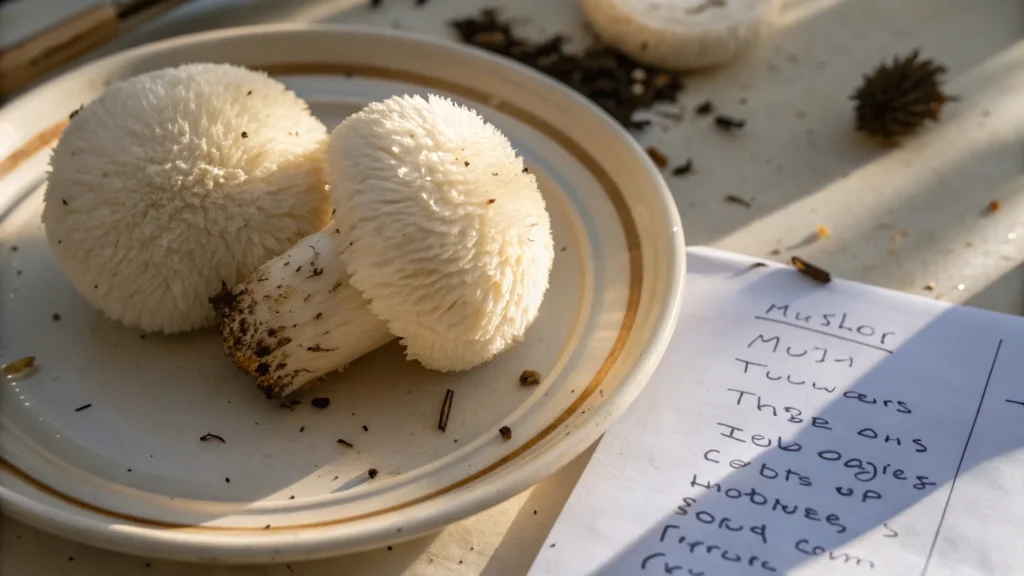
It’s got about a dozen names. Pom pom. Lion’s Mane. Monkey Head. Yamabushitake. Hericium erinaceus if you’re into Latin. Looks like a hairy cauliflower. Feels like dense memory foam. And yes it’s edible. Delicious, even.
These guys don’t grow like button mushrooms. No cap, no stem. Just this ball of white threads that looks like it belongs in a Miyazaki film. You’ll find them growing wild on dying hardwood trees, but unless you’re a trained forager (or reckless), you’re better off buying them fresh or growing your own.
What’s It Taste Like?
Here’s the weird thing: it kinda tastes like seafood. Not fishy, just… savory. Meaty. A little sweet. Imagine crab or lobster, but softer, more delicate. Sauté it right, and it gets these golden edges with a tender, juicy middle. Honestly, it’s the mushroom I use when I’m trying to convince someone mushrooms are amazing.
Also it absorbs whatever you throw at it. Garlic? Good. Soy sauce? Works. Now we’re talking.
Wild vs. Store-Bought
Wild pom poms are gorgeous but risky if you don’t know what you’re doing. I’ve seen people mistake them for other “toothy” mushrooms and get stomach issues. So unless you’ve got a guide or a serious mushroom book, just grab some at a health store or order a grow kit.
Fresh ones should look clean snowy, firm, no slimy spots. If it smells off, toss it. Don’t mess around with old mushrooms.
2. Why They’re Suddenly Everywhere
You’ve probably noticed them on a menu or heard someone on a podcast drop the words “Lion’s Mane” like it’s the next turmeric. They’re not wrong. These mushrooms are having a moment.
Some people are here for the taste. Others are here for the brain stuff. And then there are folks who just like being early to a trend. But whatever the reason, pom pom mushrooms are popping up in grocery stores, food blogs, and Reddit threads like wildfire.
Let’s break it down.
The Food Crowd Loves Them
Chefs are obsessed. It’s not every day you get a vegan ingredient that behaves like seafood and looks like it came out of a fairy tale. You can sear it like a steak. You can shred it into vegan crab cakes. You can make a garlic cream pasta and trick your guests into thinking you dropped $40 on wild scallops.
And unlike other mushroom recipes, you don’t need fifteen ingredients to make this one shine. A little oil. A hot pan. Salt. Maybe some lemon. Done.
The Wellness People Love Them Too
This is where it gets interesting. In traditional Chinese medicine, Lion’s Mane has been used for centuries to support brain health. Modern studies? They’re still early, but the compounds inside mainly hericenones and erinacines have shown potential to stimulate something called nerve growth factor.
What does that mean?
Possibly better memory. Maybe clearer focus. Some people even say they feel calmer, sharper, less foggy after eating pom pom mushrooms regularly. Is it a miracle? Probably not. But it’s promising. And honestly, even if it’s a placebo, at least it’s a delicious one.
And Then There’s The Aesthetic
Let’s be real. They look cool. Post one to Instagram and someone will ask what alien egg you’re cooking. If you’re into food photography or just like cooking weird things that look impressive on a plate, pom pom mushrooms check that box hard.
3. Cooking Pom Pom Mushrooms for the First Time
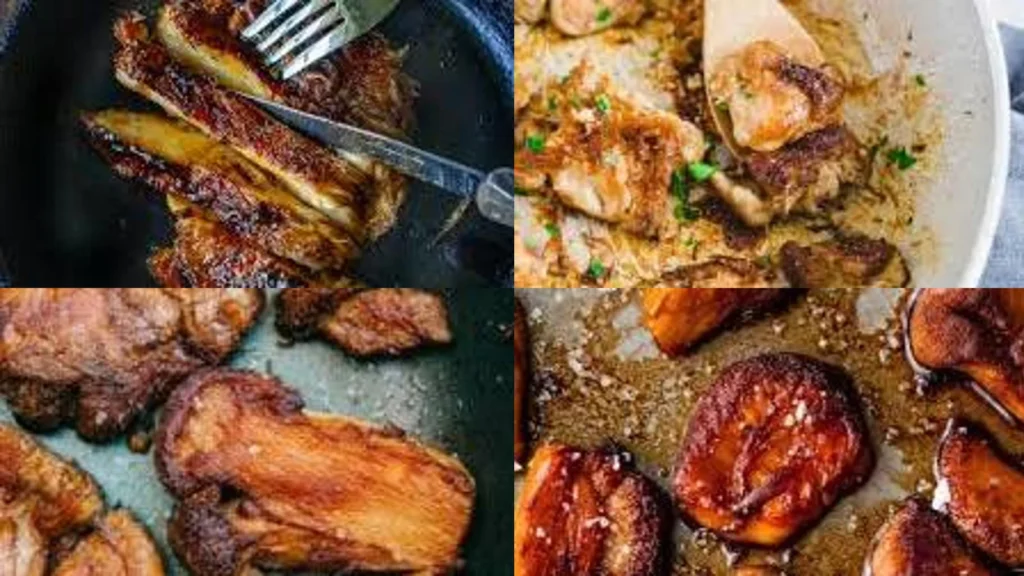
The first time I cooked pom pom mushrooms, I overthought it. I treated it like a science experiment. Watched five YouTube videos, read conflicting instructions on three blogs, and almost gave up because someone said they had to be dried first. That’s not true, by the way.
If you’ve got a fresh one, here’s all you need to know.
Learn how to cook pom pom mushrooms from scratch
Step One: Clean It, Gently
Don’t soak it. That’s mistake number one. Pom pom mushrooms are like sponges. Run water over them and they’ll absorb it fast. That ruins the texture. Instead, take a dry pastry brush or a soft towel and just brush off any dirt. If there’s something stubborn stuck in there, use a slightly damp cloth. That’s it.
If the base is woody or dark, trim it off. The rest should feel firm, fluffy, and smell earthy in a good way.
Step Two: Pull, Don’t Slice
You could slice it, sure, but you’ll lose the natural shape and texture. It’s better to tear it apart with your hands. Think of how you’d shred crab meat. The fibers pull apart easily. This helps it cook evenly and makes it look great in dishes.
Step Three: Hot Pan, No Distractions
You want a pan that’s already hot when the mushrooms hit. No oil yet. Toss the pieces in and let the moisture cook out naturally. You’ll hear a sizzle. Let it sit. Don’t stir too much. Give it time to brown.
Once the edges are a little golden and the pan starts looking dry, then you add the oil or butter. This is where the flavor starts showing up. Salt, pepper, garlic, fresh thyme.
Step Four: Taste, Adjust, Eat
Don’t wait for perfection. Take a piece, taste it. Too soft? Let it go a bit longer. Needs acid? Hit it with lemon. Dry? Add more oil. Cooking pom pom mushrooms isn’t about following exact times. It’s about watching and adjusting.
If you’re using them in a recipe like vegan crab cakes or garlic cream pasta, this basic pan technique is your foundation. Get this right and everything else gets easier.
Step-by-step guide for first-time cooks
4. Vegan-Friendly Recipes with Pom Pom Mushrooms
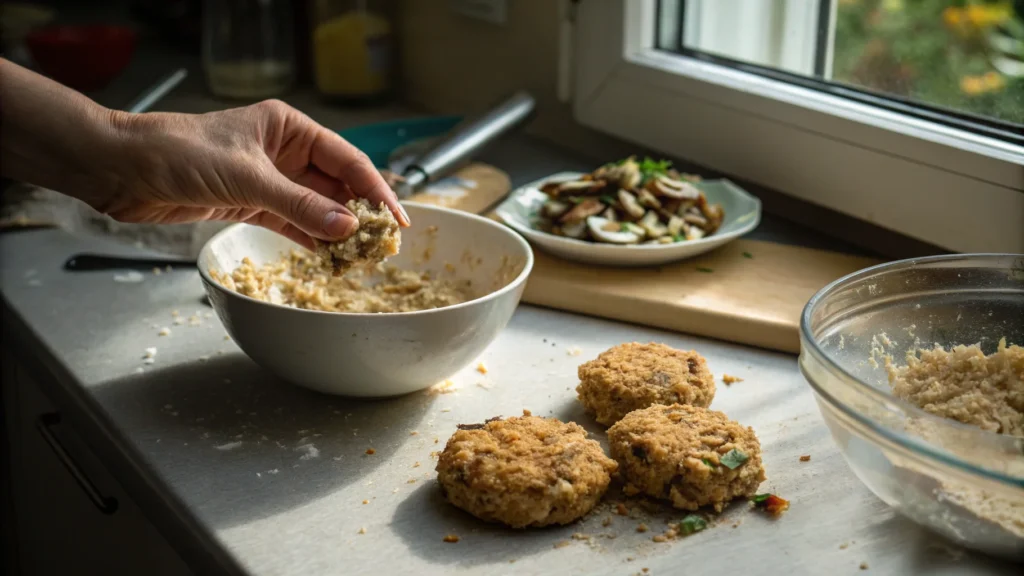
If you’re cooking plant-based, you’re probably always on the hunt for meatless options that don’t taste like cardboard. Pom pom mushrooms are the secret weapon. They’ve got this texture that somehow mimics shellfish without trying too hard. When they hit a hot pan, they crisp up around the edges and stay juicy inside. Kind of like crab. Kind of like scallops. But all mushroom.
The Star: Vegan Crab Cakes
This one’s a classic. Tear the pom pom mushrooms into chunks. Sauté them until browned. Then mix them with breadcrumbs, a little vegan mayo, Dijon mustard, Old Bay, and some chopped herbs. Add a flax egg or aquafaba if you need it to hold. Form patties. Pan fry until crisp.
Serve with lemon wedges and a quick vegan tartar sauce. You’ll fool people. In a good way.
Try these vegan crab cakes
Stir-Fry Friendly Too
If you’re in a hurry, don’t overthink it. Toss shredded pom pom mushrooms into a wok with sesame oil, garlic, soy sauce, and chili flakes. Finish with green onions. Done in ten minutes. Serve it over rice or noodles.
It’s not a recipe you follow. It’s a rhythm you get used to.
Don’t Forget the Sandwiches
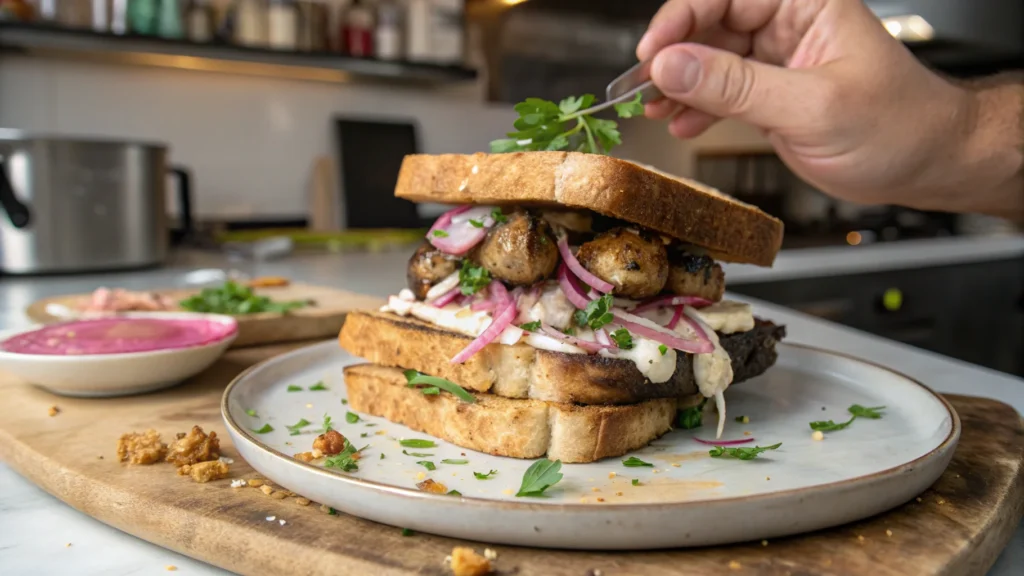
This one surprised me. Toasted sourdough. A smear of vegan aioli. Seared pom pom mushrooms, stacked high. Maybe some pickled onions and greens. That’s lunch. Or dinner. Or both.
The key is not overcooking the mushrooms. Keep them meaty, not mushy. Salt while they cook, not after. Let them do their thing in the pan without crowding them.
You Don’t Need Fancy Ingredients
That’s the thing with pom pom mushrooms. They already have flavor. You don’t need to hide it with ten other things. Olive oil, garlic, lemon, salt. That’s usually enough. If you’re feeling ambitious, try pairing them with smoked paprika or a drizzle of miso glaze.
The best vegan recipes are the ones that let the vegetables be themselves. This mushroom? It shows up ready.
5. Gourmet Meals with Pom Pom Mushrooms
This is where things get fun. Once you’ve pan-fried a few batches and figured out how these mushrooms move in the pan, it’s time to level up. Think date-night plates. Think Instagram-worthy dinners that actually taste better than they look. That’s what pom pom mushrooms bring to the table.
Garlic Cream Pom Pom Mushroom Pasta
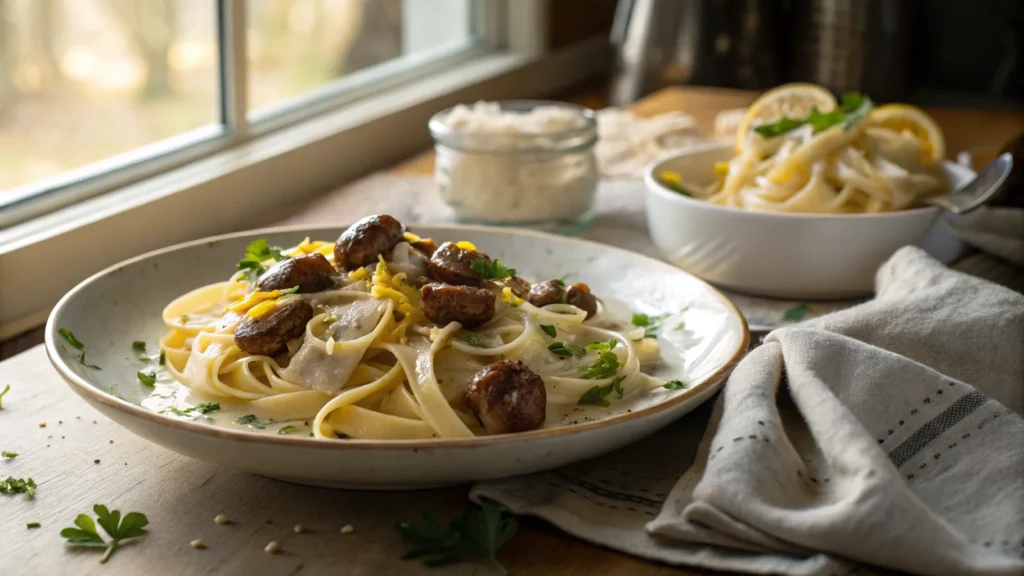
Start with garlic. Always. Sautéed low and slow in olive oil until it smells like you mean it. Then add your pom pom mushrooms, pulled into bite-sized chunks. Let them sit in the pan. No rushing. No stirring. Let them brown on one side before you even think about flipping.
Once they’re golden. Let that reduce. Add a little cashew cream or oat milk if you’re going dairy-free. Or go full cream if that’s your lane. Stir in some lemon zest, cracked pepper, maybe a touch of nutritional yeast if you want that cheesy thing without the cheese.
Toss with pasta. Fettuccine works. So does linguine. Top with parsley. Serve hot. Don’t share unless you have to.
Make this garlic cream pasta
Truffle Toasts with Pom Pom Mushrooms
Toasted sourdough. A swipe of garlic butter or vegan spread. A pile of crispy pom pom mushrooms on top, with a drizzle of truffle oil and flaky salt. That’s it. No overthinking. It’s earthy and rich and hits every flavor button at once.
Make this as a snack or serve it as an appetizer that looks way fancier than the ten minutes it took to make.
Mushroom Risotto That Doesn’t Taste Like Paste
Risotto scares people. It shouldn’t. It’s just rice and patience. Make a simple one with veggie broth, garlic, shallots, When it’s almost done, fold in some pan-seared pom pom mushrooms. They hold their texture. They don’t disappear into mush like other mushrooms. They give bite and flavor and a little bit of wow.
Finish with fresh thyme and a bit of lemon juice. Plate it like you’re at a bistro. Eat it in sweatpants.
The Trick Is Letting Them Be the Star
Don’t bury them. Don’t toss them in with ten other vegetables. Pom pom mushrooms are the main character. Build around them. Respect the crisp. Respect the chew. And don’t be afraid to serve them with nothing but salt and a drizzle of olive oil on a white plate.
Sometimes simple is gourmet.
Create gourmet meals with pom pom mushrooms
6. Nutritional Profile and Brain Benefits of Pom Pom Mushrooms
This is where things shift from the kitchen to the science lab. People aren’t just eating pom pom mushrooms because they taste good. They’re eating them because there’s real buzz about what they might do for your brain.
Discover the science-backed health benefits of pom pom mushrooms
The Basics First
Pom pom mushrooms are low in calories and high in usefulness. A standard cooked portion gives you around 30 to 40 calories, a few grams of protein, and some dietary fiber. Nothing dramatic. But the real draw is what you can’t see on the nutrition label.
Inside these mushrooms are compounds called hericenones and erinacines. They’ve been getting attention for how they interact with the nervous system. Some studies suggest they may help stimulate something called nerve growth factor, or NGF. This is a protein that plays a big role in keeping your brain cells alive and functioning.
That doesn’t mean pom pom mushrooms are medicine. But it does mean there’s some interesting research around their potential.
So What Can They Do?
Here’s what’s being explored. Improved memory. Better focus. Less mental fog. Some small studies have shown that taking Lion’s Mane mushroom extract regularly may support cognitive performance in older adults. Other research is looking at how it might help with mood, even anxiety.
It’s not magic. And it’s not a shortcut. But if you’re already working on better sleep, nutrition, hydration, and movement, adding pom pom mushrooms to your meals could be a solid piece of that puzzle.
Eat Them Whole or Take a Supplement?
There’s debate here. Some people swear by the powders or capsules. Others prefer to eat the real thing. Cooking with fresh pom pom mushrooms not only gives you flavor, but also delivers those same compounds, especially if you’re cooking them gently and not burning them to a crisp.
The benefit of eating them whole is that you’re getting more than just one extract. You’re getting the full spectrum of nutrients and fibers.
How Often to Eat Them?
There’s no strict rule. Some people eat them a few times a week. Others make them part of a rotation with other functional mushrooms like shiitake or maitake. Listen to your body. Track how you feel. And if you’re thinking about using them for health reasons, always check with a professional.
Cognitive health benefits of Lion’s Mane
7. Buying Pom Pom Mushrooms: Fresh, Wild, or Dried?
When it comes to getting your hands on pom pom mushrooms, there are a few ways to go. Each has its pros, its quirks, and its own little learning curve. Whether you’re shopping in person or clicking through pages online, the key is knowing what good quality looks like and where to find it.
Fresh Is Best When You Can Find It
If you’ve never tried pom pom mushrooms before, fresh is the way to start. You’ll get the full flavor, the true texture, and all the cooking possibilities. Look for them at local farmers markets, natural food stores, or co-ops. They’re not as common as portobello or shiitake, but they’re showing up more often now.
A good one will be white or off-white, dense to the touch, and dry on the surface. Skip anything that feels slimy, smells sour, or has dark spots. If it looks tired, it probably is.
Wild Foraging: Only If You Know What You’re Doing
Pom pom mushrooms grow naturally on hardwood trees, especially in cooler months. You’ll sometimes spot them clinging to dead or decaying trunks in the wild. They stand out. Big, fluffy, almost glowing in the right light.
That said, unless you’ve been trained or are with someone who knows their mushrooms, don’t eat anything you pick. There are look-alikes that can upset your stomach or worse. Foraging is rewarding, but it comes with risk. No mushroom is worth guessing on.
Grow Kits for the Win
If fresh isn’t available near you and foraging is off the table, consider a Lion’s Mane grow kit. They’re simple to use. You mist them, keep them in a slightly humid space, and wait. In a week or two, your own crop of pom pom mushrooms starts to push through.
They don’t take up much room. A kitchen counter or a spot by a window works fine. And once they fruit, they’re just as tasty as anything from the store.
Dried or Powdered?
Dried pom pom mushrooms are less common than dried shiitake, but they’re out there. Rehydrating them brings back some of the texture, though not all of it. They work best in broths, teas, or blended into sauces. The flavor is still strong, but you lose that signature chew.
Powdered versions are more for supplements or smoothies. You won’t get the full culinary experience, but you might still get some of the potential health benefits. If you’re here for flavor, stick with fresh.
Get the most out of your mushrooms from shopping to prepping
8. How to Store and Prep Pom Pom Mushrooms for Maximum Flavor
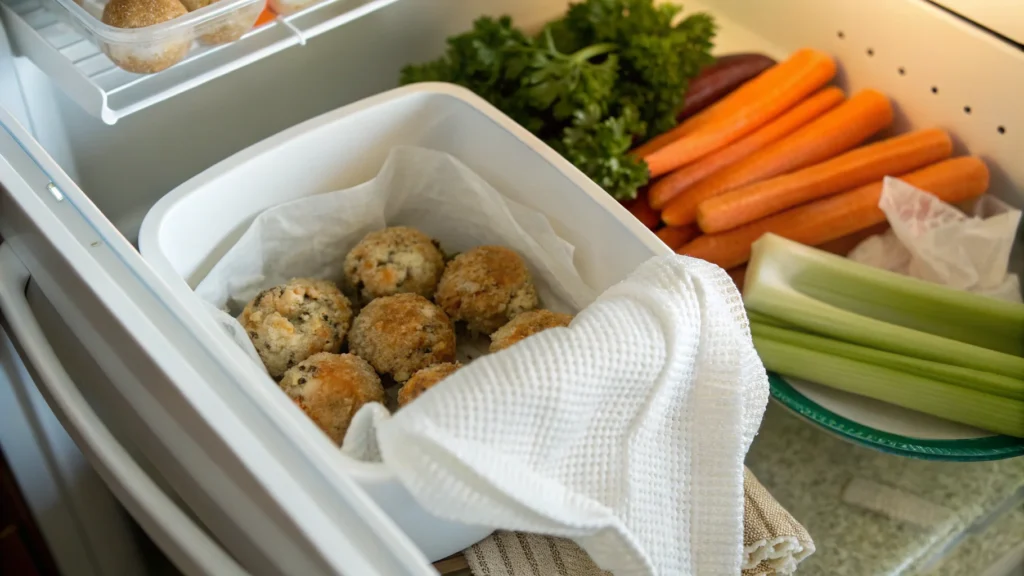
The way you handle pom pom mushrooms before they hit the pan matters more than most people think. These mushrooms are delicate. They hold water. They bruise easily. But when treated right, they deliver flavor and texture that’s hard to beat.
Storing Them the Right Way
If you’ve bought fresh pom pom mushrooms, don’t shove them in a plastic bag and forget them in the fridge. They need air. Plastic traps moisture and that leads to slime, and slime leads to waste.
Instead, wrap them loosely in a paper towel and place them inside a paper bag or a breathable container. Keep them in the fridge, preferably in the produce drawer. You want cool but not damp. Stored this way, they’ll last around five to seven days. Check them every couple days. If they start to darken or feel soggy, use them sooner.
Can You Freeze Them?
Yes, but only after cooking. Raw pom pom mushrooms don’t freeze well. Their water content makes them go soft and lose that meaty bite. If you’ve made a batch and want to keep leftovers, let them cool fully, then freeze them in a sealed container. Reheat in a pan to bring back the texture.
Freezing works best for stir-fry chunks or cooked slices you plan to toss into something else later. Don’t expect the same crisp as fresh, but the flavor holds.
Cleaning Without Ruining Them
This is where beginners often mess up. Never soak pom pom mushrooms in water. They’ll act like sponges. You’ll end up with soggy, lifeless pieces that cook unevenly and taste flat.
Instead, use a soft brush or dry towel. Gently remove dirt or debris from the surface. If you must use water, make it quick. A light rinse followed by a careful pat dry with a cloth. Then let them breathe on a clean towel for a few minutes before cooking.
Prepping: Tear, Don’t Chop
Forget the knife. Use your hands. Tear the mushroom apart into bite-sized pieces. The natural fibers shred in a way that mimics crab or pulled meat. This gives you more surface area to brown and keeps the texture intact.
If you’re making something fancy like garlic cream pasta or a layered toast, tear them a bit smaller so they sear faster and don’t overpower the dish.
Clean and store pom pom mushrooms the right way
9. Foraging and Growing Your Own Pom Pom Mushrooms
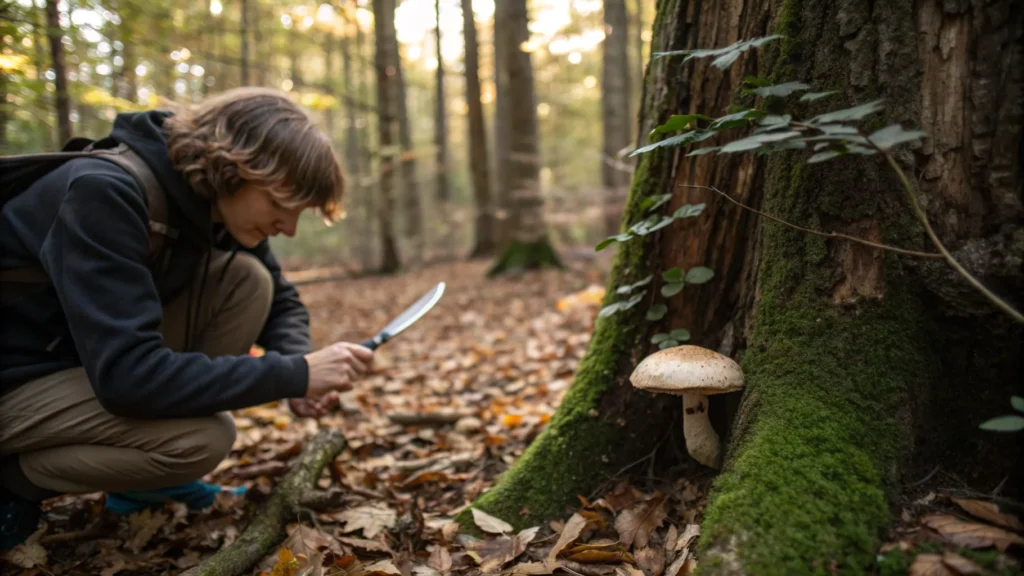
There’s something different about eating food you didn’t buy. Whether you pulled it from the dirt or cut it from a tree, it changes the experience. Pom pom mushrooms are no exception. You can find them in the wild or grow them at home, and both paths have their rewards.
Spotting Them in the Wild
Pom pom mushrooms grow on hardwood trees. You’ll mostly see them on dead or dying trunks. They show up in late summer through fall, especially in cooler, damp forests. They’re easy to recognize. No cap. No gills. Just white spines that droop like a lion’s mane. The surface should look soft, like thread or fur. The color should be clean, creamy white. If it’s yellowed or starting to collapse, it’s past its prime.
They don’t grow in clusters. Just one solid mass. That’s a key difference from some look-alikes.
If you’re serious about foraging, get a good field guide. Better yet, go with someone who knows their stuff. There’s no prize for guessing wrong when it comes to wild mushrooms.
Harvesting Without Harm
When you find a fresh one, cut it gently at the base with a clean knife. Don’t pull it. Don’t rip it. Leave the area around it undisturbed. That helps the mycelium underground keep doing its thing. A healthy patch can fruit again the next season if you respect it.
Bring a breathable basket or paper bag. Never use plastic when foraging. It traps moisture and speeds up spoilage. Once home, store your pom pom mushrooms like you would any fresh batch. Brush, trim, chill.
Growing Them Indoors
This is the easy route, and it’s a good one. You can buy Lion’s Mane grow kits online that are almost plug and play. Most come with a block of substrate already colonized by mushroom spawn. All you do is cut a slit in the bag, mist it a couple times a day, and keep it in a shady spot with decent air flow.
In about two weeks, you’ll see white puffballs start to form. They grow fast. Once they’re the size of a fist and still white and firm, they’re ready. Cut them clean, cook the same day or store as usual.
Why Grow Them Yourself?
Freshness is one reason. Another is the satisfaction of making something from nothing. But there’s also the cost. Buying pom pom mushrooms at the store can get expensive. Growing your own gives you more control and, often, more supply.
Plus, they look amazing on your kitchen counter.
FAQs
You’ve made it this far. Maybe you’ve already cooked with pom pom mushrooms, maybe you just bought your first one and are still staring at it like it might blink. Either way, these are the questions people ask the most. Quick, honest answers. No fluff.
Can I Eat Pom Pom Mushrooms Raw?
Technically, yes. But you probably shouldn’t. Raw pom pom mushrooms can be tough, spongy, and a little bitter. Cooking them brings out the umami flavor and softens the texture. A hot pan does them a lot of good.
Do They Taste Like Regular Mushrooms?
Not really. Most people say pom pom mushrooms taste more like seafood than traditional mushrooms. They don’t have that earthy, dirt-heavy thing that portobello or cremini mushrooms have. Think mild, buttery, with a texture that’s closer to crab meat than anything else.
Are They Safe for Kids?
Generally, yes. But like with any new food, start small. If your kid is allergic to other mushrooms or has a sensitive stomach, talk to a doctor first. And always cook them fully.
How Long Do They Last in the Fridge?
If stored properly, fresh pom pom mushrooms will keep for five to seven days. Use a paper bag or wrap them in a towel. Keep them away from moisture. Check them every couple days. If they feel slimy or smell sour, toss them.
Can I Grow Them in a Small Apartment?
Yes. That’s one of the best things about pom pom mushrooms. A simple grow kit and a little attention can give you fresh mushrooms in a matter of weeks. No backyard required. Just a kitchen corner, a spray bottle, and a little patience.
What’s the Best Way to Cook Them?
Start dry. Medium heat. No oil at first. Let the water cook out naturally. Then add fat. Salt. Maybe garlic. Let them brown. Keep them moving once they start crisping. That’s the sweet spot.
Can I Use Them in Place of Meat?
Absolutely. In vegan recipes, pom pom mushrooms are often used as a stand-in for crab, scallops, even pulled pork. Their texture holds up. Their flavor soaks in whatever you add. They bring chew. They bring satisfaction.